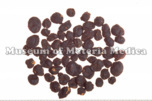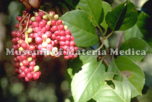Schisandra Fruit

|
Market name:五味子 Photo location:Museum of Materia Medica, Inst. of Nat. Med. TMPW No.:1357 |

|
Plant name:Schisandra chinensis Photo location:Gansu Prov., China Photo date:1992 Photographer:K. Komatsu |
| Synonym | |
| Latin name | Schisandrae Fructus |
| Botanical source: Family name | Schisandraceae |
| Botanical source: Plant name | Schisandra chinensis Baillon (IPNI:60456331-2) |
| Part used | Dried ripe fruit |
| Empirical criteria for quality selection | Good one is deep purple in color and has wrinkles on the surface. It tastes sweet. (TN) |
| Constituents | Other aliphatic and related compounds: Fumaric acid, Citric acid, Malric acid, Tartaric acid Monoterpenoids: Citral Sesquiterpenoids: Sesquicarene, α-Ylangene, α-Chamigrene, β-Chamigrene, Chamigrenal Sterols: β-Sitosterol Lignans & Neolignans: Schizandrin (= Schizandrol A), Gomisin A (= Schizandrol B), Gomisin B, Gomisin C, Gomisin D, Gomisin E, Gomisin F, Gomisin G, Schizandrin A (= Deoxyschizandrin), Schizandrin B, Schizandrin C, Schizandrel A, Schizandrel B; Pregomisin |
| Pharmacological effects | Suppression of gastric juice secretion, stimulation of bile secretion (schizandrin). Sedative, analgesic, decreases body temperature, relaxation of muscles, suppression of stress-induced ulcer (schizandrin, gomisin A). Antitussive (gomisin A). Ataxia, induction of spasm, appearance of arousal brain wave (coal oil-ether extract). |
| Indications | As an antibechic, astringent, antidiarrheal and tonic, it is applied to treat hepatic disorder and the diseases with thirst, cough, diarrhea and phlegm. |
| Diseases | Cough, Dyspnea, Spontaneous sweating, Night sweats, Frequent urination, Incontinence of urine, Diarrhea, Thirst, Malaise, Lack of energy, Palpitation |
| Formulas | kamiuntanto , kamishimotsuto , kyososan , shoseiryuto , shoseiryutokakyoninsekko , shoseiryutokasekko , seishoekkito , seinetsuhokito , seinetsuhoketsuto , seihaito , ninjin'yoeito , fuhishomyakusan , hohaito , mibakujiogan , yakanmaoto , ryokankyomishingeninto , ryokeimikanto |
| Meridian tropism | Lung, Kidney |
| Property | Warm |
| Flavor | Sour |
| Classification in "Shen-non Ben-cao Jing" | Superior |
| TCM: Classification | Astringents and hemostatis |
| TCM: Medicinal effects | To arrest discharges, replenish qi, promote fluid secretion, tonify the kidney, and induce sedation. Used for chronic cough and asthma, nocturnal emission, spermatorrhea, enuresis, frequent urination, protracted diarrhea, spontaneous sweating, night sweat, impairment of body fluid with thirst, shortness of breath and feeble pulse, diabetes caused by internal heat, palpitation and insomnia. |
| Remarks | Listed in the Japanese Pharmacopoeia 18th ed. |
| References | TN: T. Namba & Y. Tsuda ed., Outline of Pharmacognosy, a Textbook, 3rd ed., Nankodo Co., Ltd., Tokyo, 1998. |
DNA sequences of medicinal plants
| Gene Region | |||||||||||||||||||
| Nuclear | Chloroplast | Mitochondria | |||||||||||||||||
| Botanical source: Plant name | 5Ss | 18S | ITS1 | 5.8S | ITS2 | 26S | others | trnH-psbA | matK | trnK | trnK-rps16 | trnT-L | trnL | trnL-F | rbcL | rpoC1 | ndhF | others | |
|
|
|||||||||||||||||||
